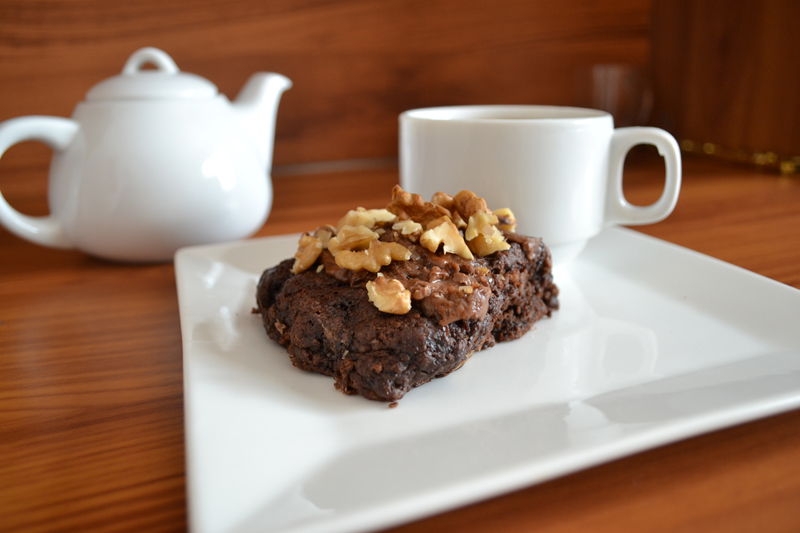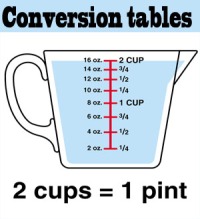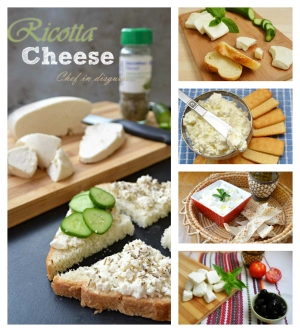Audax Artifex was our January 2012 Daring Bakers’ host. Aud worked tirelessly to master light and fluffy scones (a/k/a biscuits) to help us create delicious and perfect batches in our own kitchens!
I was really excited when this month’s challenge was announced. Scones are the perfect companion to the afternoon tea, a wonderful idea for a special breakfast and a great quick option when you have guests coming over on short notice. They are quick and easy, versatile and a great recipe to enjoy making with the kids.
Audax did a great amount of work and research and provided us with an amazingly informative challenge. Please take the time to visit his blog and read his post. I promise you, you will learn so much and will never look at scones the same way again.

To master making scones you need to know a little about the main ingredients: flour, liquid, chemical raising agents and fat.
Flour: I used finely milled OO flour, all purpose flour and pastry flour and I have to say that the OO flour gave the tallest and lightest scones but not by far. Audax suggested triple sifting the flour and I guess that helped reduce the difference between the types of flour.
Fat: You can use butter or shortening. I went for butter for flavor.
Liquid: milk, buttermilk, soured milk, half-and-half, cream. I even used half orange juice and half milk in one batch to infuse it with orange flavor.
Chemical raising agents always use fresh raising agents, baking powder deteriorates within two months once the jar is opened, the recommended dose is about 2 teaspoons per cup of flour. Baking powder nowadays is double action – there is an initial release of gas once the dry and wet ingredients are combined and there is another release of gas from the high heat of the oven. If you are using acidic ingredients (such as buttermilk, soured milk, cream, honey, cheese, tomato sauce etc) then use an additional ¼ teaspoon of baking soda per cup of liquid to help neutralise the acid and make the final baked product raise correctly. Baking soda is four times stronger in raising power than baking powder. You can make you own single action baking powder by triple sifting together one part baking soda and two parts cream of tartar store in an airtight container.

Techniques and tips to get great scones
Triple sift the dry ingredients – sift your dry ingredients from a height this permits plenty of air to be incorporated into the mixture which allows for maximum lightness in your scones and ensures even distribution of all the raising agents and other ingredients
Rubbing in the fat this is the part that allows you to control how flaky or tender your scones will come out. If you rub the fat in to the point it resembles fine bread crumbs the resulting scone will be soft and tender. On the other hand if you rub the fat in leaving some large particles (the size of peas) the resulting scone will be flaky. I tried grating the butter and then freezing it vs cutting it into cubes and I found that the grated frozen butter gave the best results. The final scones were laminated and crisp on the outside.
Moistening and bringing the dough together – add nearly all of the liquid at once to the rubbed-in dry ingredients. When mixing the dough (I used my finger tips but feel free to use a spatula), mix just until the dough is well-moistened and begins to just come together it will be wet (and sticky). And remember the old saying – the wetter the dough the lighter the scones (biscuits)! Then turn the dough onto a lightly floured board.
Handling the dough – Here you have two problems to avoid, overworking and underworking the dough.Over worked dough will result in tough, dry scones. Under working them will result in your scones being crumbly

Basic Scones (a.k.a. Basic Biscuits)
recipe and instruction from Audax
Servings: about eight 2-inch (5 cm) scones or five 3-inch (7½ cm) scones
Recipe can be doubled
Ingredients:
1 cup (240 ml) (140 gm/5 oz) plain (all-purpose) flour
2 teaspoons (10 ml) (10 gm) (⅓ oz) fresh baking powder
¼ teaspoon (1¼ ml) (1½ gm) salt
2 tablespoons (30 gm/1 oz) frozen grated butter (or a combination of lard and butter)
approximately ½ cup (120 ml) cold milk
optional 1 tablespoon milk, for glazing the tops of the scones
Directions:
1. Preheat oven to very hot 475°F/240°C/gas mark 9.
2. Triple sift the dry ingredients into a large bowl. (If your room temperature is very hot refrigerate the sifted ingredients until cold.)
3. Rub the frozen grated butter (or combination of fats) into the dry ingredients until it resembles very coarse bread crumbs with some pea-sized pieces if you want flaky scones or until it resembles coarse beach sand if you want tender scones.

4. Add nearly all of the liquid at once into the rubbed-in flour/fat mixture and mix until it just forms a sticky dough (add the remaining liquid if needed). The wetter the dough the lighter the scones (biscuits) will be!
5. Turn the dough out onto a lightly floured board, lightly flour the top of the dough. To achieve an even homogeneous crumb to your scones knead very gently about 4 or 5 times (do not press too firmly) the dough until it is smooth. To achieve a layered effect in your scones knead very gently once (do not press too firmly) then fold and turn the kneaded dough about 3 or 4 times until the dough has formed a smooth texture. (Use a floured plastic scraper to help you knead and/or fold and turn the dough if you wish.)I used the folding technique and here is a step by step

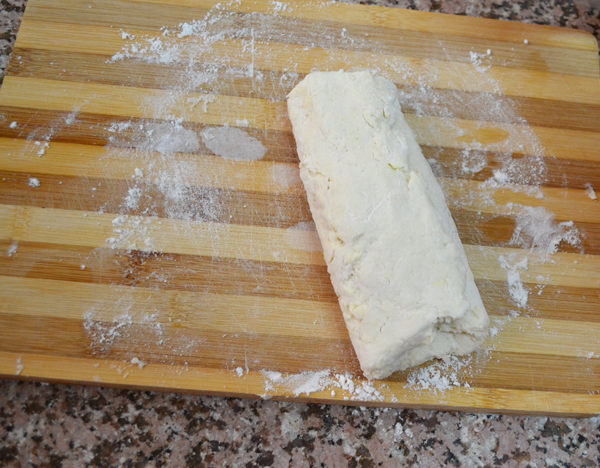
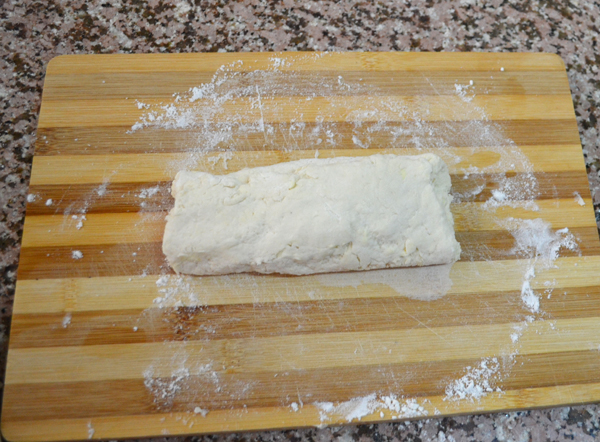
6. Pat or roll out the dough into a 6 inch by 4 inch rectangle by about ¾ inch thick (15¼ cm by 10 cm by 2 cm thick). Using a well-floured 2-inch (5 cm) scone cutter (biscuit cutter), stamp out without twisting six 2-inch (5 cm) rounds, gently reform the scraps into another ¾ inch (2 cm) layer and cut two more scones (these two scones will not raise as well as the others since the extra handling will slightly toughen the dough). Or use a well-floured sharp knife to form squares or wedges as you desire.
7. Place the rounds just touching on a baking dish if you wish to have soft-sided scones or place the rounds spaced widely apart on the baking dish if you wish to have crisp-sided scones. Glaze the tops with milk if you want a golden colour on your scones or lightly flour if you want a more traditional look to your scones.
8. Bake in the preheated very hot oven for about 10 minutes (check at 8 minutes since home ovens at these high temperatures are very unreliable) until the scones are well risen and are lightly coloured on the tops. The scones are ready when the sides are set.
9. Immediately place onto cooling rack to stop the cooking process, serve while still warm.
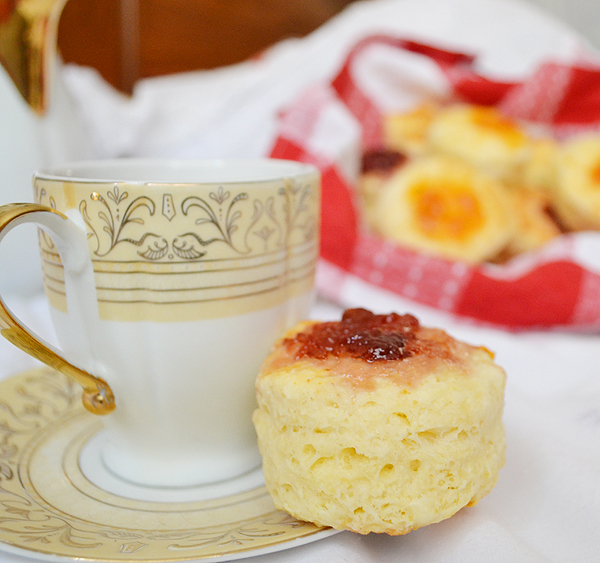
Variations on the Basic recipe
I made 5 variables, the basic recipe, basic topped with jam before baking, feta olives and sundried tomato scones, cheddar rosemary and garlic scones and finally chocolate nutella scones. I will include the recipes I used along with Audax’s suggestions for more variables

Variations on the Basic recipe
Buttermilk – follow the Basic recipe above but replace the milk with buttermilk, add ¼ teaspoon of baking soda, increase the fat to 4 tablespoons, in Step 3 aim of pea-sized pieces of fat coated in flour, in Step 5 fold and turn the dough, rounds are just touching in the baking dish, glaze with buttermilk.
Australian Scone Ring (Damper Ring) – follow the Basic recipe above but decrease the fat to 1 tablespoon, in Step 3 aim of fine beach sand sized pieces of fat coated in flour, in Step 5 knead the dough, in Step 7 form seven rounds into a ring shape with the eighth round as the centre, glaze with milk.
Cream – follow the Basic recipe above but replace the milk with cream, add ¼ teaspoon of baking soda, in Step 3 aim of beach sand sized pieces of fat coated in flour, in Step 5 knead the dough, rounds are just touching in the baking dish, glaze with cream.
Cheese and Chive – follow the Basic recipe above but add ¼ teaspoon of baking soda, after Step 2 add ½ teaspoon sifted mustard powder, ¼ teaspoon sifted cayenne pepper (optional), ½ cup (60 gm/2 oz) grated cheese and 2 tablespoons finely chopped chives into the sifted ingredients, in Step 3 aim of beach sand sized pieces of fat coated in flour, in Step 5 knead the dough, rounds are widely spaced in the baking dish, sprinkle the rounds with cracked pepper.
Fresh Herb – follow the Basic recipe above but after Step 3 add 3 tablespoons finely chopped herbs (such as parsley, dill, chives etc).
Sweet Fruit – follow the Basic recipe above but after Step 3 add ¼ cup (45 gm) dried fruit (e.g. sultanas, raisins, currents, cranberries, cherries etc) and 1 tablespoon (15 gm) sugar.
Wholemeal – follow the Basic recipe above but replace half of the plain flour with wholemeal flour.
Wholemeal and date – follow the Basic recipe above but replace half of the plain flour with wholemeal flour and after Step 3 add ¼ cup (45 gm) chopped dates and 1 tablespoon (15 gm) sugar.
Cheddar rosemary garlic scones
Basic scone recipe
2 table spoons shredded sharp cheddar
1 tablespoon parmessan
1/4 teaspoon garlic powder
1/2 teaspoon paprika
1 tablespoon rosemary
Add the cheese, rosemary and spices to the dry ingredients after sifting and continue with recipe.

Feta olives and sun-dried tomato scones
Inspired by a recipe from BBC food
- Basic scone recipe
- 3 tablespoons feta
- 1/3 cup pitted black olives
- 5-6 sun dried tomatoes drained from oil and chopped
- 1 teaspoon italian seasoning + more to sprinkle on top
After rubbing in the butter add the feta, olives, tomatoes and seasoning and stir to combine then carry on with the recipe
Storage & Freezing Instructions/Tips:
Scones are best eaten warm. Scones (biscuits) are really easy to store – bag the cooked and cooled scones and freeze until needed then reheat in a moderate hot for a few minutes.
Chocolate Nutella scones
This was the only time I didn’t use the challenge recipe, this recipe comes from Baked Explorations cookbook and I have to say I liked the challenge recipe better. This scone was more cake like in consistency rather than flaky and crisp. I think next time I will try to make them with the basic scone recipe.
2 cups unbleached all-purpose flour
1/4 cup granulated sugar
1/4 cup dark sweetened cocoa powder
1 tablespoon baking powder
1/2 teaspoon salt
6 tablespoons (3/4 stick) cold unsalted butter, cut into chunks
1 large egg
1/2 cup heavy cream
3/4 cup toasted hazelnuts, coarsely chopped
1/2 cup Nutella
Preheat the oven to 375 degrees F. Line baking sheet with parchment paper.
Place flour, sugar, cocoa powder, baking powder, and salt in the bowl of a food processor fitted with a metal blade. Process with six 1-second pulses.
Remove cover of food processor and sprinkle the butter evenly over the dry ingredients. Cover and process with 12 1-second pulses. Transfer contents to a large bowl.
In a medium bowl, whisk together the egg and cream. Stir into the flour mixture just until moistened. Add the toasted hazelnuts and knead gently to incorporate. Knead the dough by hand 6 to 8 times (do not overprocess or scones will be tough).
Flatten the dough into a rectangle approximately 6 by 12 inches and spread 1/4 cup of the Nutella on top in a criss-cross pattern.
Roll the dough up to make a cylinder about 6 inches long, turn it on its end, and gently flatten it into a disk about 1 3/4 inches high. Do not overwork the dough.
Cut the dough into 6 or 8 wedges and place them on the prepared baking sheet.
Bake the scones for 18-20 minutes, rotating the baking sheet halfway through, or until a toothpick inserted into the center of a scone comes out clean. Transfer the scones to a wire rack to cool completely. Place the baking sheet with the parchment still on it underneath the rack.
Heat the remaining 1/4 cup Nutella in a microwave until pourable, about 10 seconds on high. Pierce the tops of the scones a few times with a fork. Use a spoon ( or two spoons-one to scoop, one to scrape) to drip the warm Nutella in a zigzag pattern over the tops of the hot scones. Transfer them to a refrigerator to set for 5 minutes, then serve immediately.






